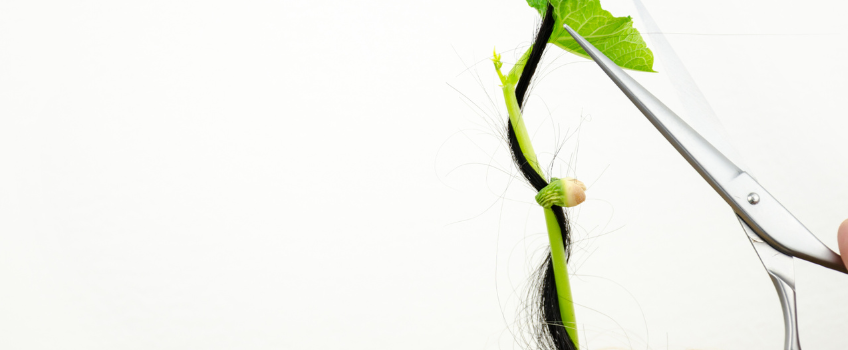
The circulatory system plays a crucial but often underappreciated role in hair growth.
Hair follicles, like any other part of the body, need nutrients, oxygen, and waste removal to function properly, and these are all provided by the blood. The oxygen and nutrients supplied by the blood are essential for the production of our hair proteins. Waste removal provided by our circulatory system also eliminates toxins that can damage hair follicles if not removed. Without a properly functioning circulatory system, hair growth would be significantly hindered.
Here are some hair growth facts you need to know:
1. Why is blood circulation so critical for hair development?
Blood circulation is critical for overall hair development because it delivers essential nutrients, oxygen, and chemicals to hair follicles, which are essential for overall hair growth. Hair growth and maintenance require these essential elements to be continuously supplied to hair follicles. Poor circulation can inhibit the proper supply of nutrients to the hair follicles, leading to issues such as hair loss and weak, brittle hair. It is important to maintain a healthy circulation system in order to ensure that the hair follicles are adequately supplied with the necessary elements for healthy hair growth.
If blood circulation to the scalp is compromised, for example, due to poor lifestyle habits, certain medical conditions, or genetics, it can lead to a reduction in hair growth, thinning of hair, or even hair loss. Therefore, maintaining healthy blood circulation is crucial for healthy hair development and overall scalp health.
2. What are the stages of hair development?
Hair development undergoes various stages, including the anagen (growth) stage, catagen (transition) stage, and telogen (resting) stage. During the anagen stage, hair grows from the root and can last for several years. The catagen stage is a brief transition period where the hair follicle shrinks. Lastly, the telogen stage is a resting period, where the hair stops growing and eventually sheds. The anagen stage is key for hair growth as the hair follicles actively produce newly formed hair cells at this stage. Hair follicles need an adequate supply of nutrients and oxygen to support this process.
3. How do hormonal imbalances affect hair growth?
Hormonal imbalances can significantly impact hair growth. The pituitary gland, thyroid gland, and sex glands (testicles in males and ovaries in females) play vital roles in regulating hormonal balance in the body, which can influence hair growth. Overproduction or underproduction of certain hormones, such as FSH (Follicle-stimulating hormone) from the pituitary gland, can disrupt the hair growth cycle.
Thyroid gland imbalances (hypothyroidism or hyperthyroidism) can result in changes in hair texture and even lead to hair thinning and loss of hair, as a result of the imbalances in the thyroid hormones. In both men and women, imbalances in sex hormones, i.e. testosterone and estrogen, can cause hair thinning and hair loss. In some cases, hormonal imbalances can also cause excessive hair growth (known as hirsutism) in unwanted body areas.
4. How does dihydrotestosterone (DHT) affect hair growth in men?
Excessive levels of dihydrotestosterone (DHT), a derivative of testosterone, can lead to male pattern baldness (androgenetic alopecia) in men. Hair loss is caused by hair follicle sensitivity to DHT. This hereditary condition is characterized by a receding hairline and thinning hair on the crown. DHT is produced by an enzyme from testosterone and binds to receptors in the hair follicle. This causes the follicle to shrink and reduces the production of new hair.
Over time this can lead to baldness. Additionally, male pattern baldness is very common, with estimates that between 25% and 66% of men will experience some degree of hair loss by the age of 35. This process of DHT binding to hair follicles is thought to be genetically inherited. It is more likely to occur in men with a family history of baldness. Furthermore, this condition is more common in men than women, as men have a higher concentration of testosterone which increases DHT production.
5. How does polycystic ovary syndrome (PCOS) affect hair growth in women?
Conditions like polycystic ovary syndrome (PCOS) can lead to excessive hair growth in specific areas due to elevated androgen (male hormone) levels, leading to hirsutism (unwanted hair growth). PCOS can also cause hair thinning and loss due to hormonal imbalances.
This can be a difficult condition to live with, both physically and emotionally. Treatment can include hormone therapy as well as lifestyle changes. It is important to seek medical advice if you are experiencing any of these symptoms. Changes in hormone levels, such as an increase in androgens, can cause hair thinning and loss. It can also cause other symptoms such as irregular periods, acne, and weight gain. Treatment involves addressing the underlying cause as well as managing any symptoms such as laser hair removal.
6. Why is hormonal balance so crucial for hair health and growth?
Hormonal balance is essential for hair health and growth. This is because hormones regulate the hair growth cycle and maintain hair follicle integrity. Hormonal imbalances can disrupt hair growth, leading to hair thinning and loss or excessive hair growth in unwanted areas. Hormones also play a role in the health of the scalp and the production of natural oils that keep the hair and scalp hydrated. Imbalanced hormones can lead to an unhealthy and dry scalp, which can make hair brittle and prone to breakage.
7. What are the key factors
Satisfactory blood circulation is fundamental for hair development as it supplies nutrients and oxygen to the hair follicles. Maintaining hormonal balance, especially in the pituitary, thyroid, and sexual glands, is crucial for hair growth. Adequate levels of thyroid hormones, testosterone, and estrogen are necessary for healthy hair growth and texture. It is also important to consume a balanced diet, rich in proteins and vitamins, to keep hair healthy. Additionally, reducing stress levels can be beneficial for hair growth.
8. How does PRP impact blood circulation?
Platelet-Rich Plasma (PRP) therapy is a treatment method used for a variety of medical conditions, including hair loss. The treatment involves drawing a patient’s own blood, processing it so that only the enriched cells (platelet-rich plasma) remain, and injecting it into the scalp.
PRP contains a higher concentration of platelets compared to normal blood. These platelets are a source of growth factors and cytokines that have regenerative properties and can stimulate healing and tissue regeneration.
When PRP is injected into the scalp, it can help to improve blood circulation in several ways:
Angiogenesis: One of the key ways PRP can improve circulation is by promoting angiogenesis, the process of forming new blood vessels. Growth factors in PRP, such as Vascular Endothelial Growth Factor (VEGF), stimulate the formation of new blood vessels in the scalp. These new vessels improve the blood supply to the hair follicles, bringing more nutrients and oxygen to them and promoting hair growth.
Stimulation of Hair Follicles: PRP can stimulate the hair follicles to enter the active growth phase (anagen phase), which can result in new hair growth. This is due to the presence of growth factors like Platelet-Derived Growth Factor (PDGF) and Transforming Growth Factor (TGF), which play a role in cellular proliferation and differentiation.
Decreasing Inflammation: The anti-inflammatory properties of PRP can help decrease inflammation in the scalp that might be restricting blood flow.
Collagen Production: PRP can stimulate the production of collagen, a protein that helps to strengthen the scalp tissue and improve its elasticity, which can promote better blood flow.
Conclusion
The endocrine system, which includes all the glands that produce hormones, plays a vital role in maintaining the health of our hair. Imbalances in these hormones can lead to a range of hair problems, from thinning and brittleness to full hair loss. Therefore, a balanced diet, a healthy lifestyle, and regular check-ups to detect any hormonal imbalances early can go a long way in maintaining healthy hair growth.
To book your complimentary consultation appointment, call us at 416-548-6548 Book a Consultation
